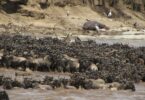What Is Hibernation?
Hibernation is a prolonged state of reduced metabolic activity that allows animals to survive when resources are limited. During this time, an animal’s heart rate, breathing rate, and body temperature decrease significantly, helping it conserve energy.
How Do Animals Hibernate?
- Preparation: Before hibernation, many animals engage in a phase called hyperphagia, where they eat excessively to build fat reserves. This fat acts as an energy source during the long sleep. For example, bears can gain significant weight in the months leading up to winter.
- Entering Hibernation: As temperatures fall, animals find a safe place to hibernate—caves, burrows, or nests—where they can stay warm and protected from harsh weather and predators.
- Metabolic Changes: During hibernation, the animal’s body undergoes remarkable metabolic changes. For instance, a bear’s heart rate can drop from 60 beats per minute to as low as 10 beats. This profound slowdown conserves energy, allowing the animal to survive without food.
Why Do Animals Hibernate?
1. Food Scarcity
As winter approaches, many food sources, such as berries, nuts, and insects, become limited. Hibernating animals avoid the struggle of searching for food during this difficult time by entering a state of dormancy.
2. Temperature Regulation
Hibernation helps animals conserve energy in response to cold temperatures. By lowering their metabolism, they can survive the winter months without needing to eat regularly. This energy conservation is crucial for their survival until spring.
3. Predator Avoidance
Sleeping through the harshest months also reduces the risk of encountering predators. Hibernating in a safe location allows animals to rest and recuperate without the constant threat of being hunted.
Examples of Hibernating Animals
1. Bears
Bears are perhaps the most well-known hibernators. Before winter, they enter a phase of hyperphagia, eating excessively to store fat. Interestingly, they can wake briefly during hibernation, often to give birth to their cubs. This unique adaptation allows them to care for their young in a safe environment.
2. Ground Squirrels
These small mammals hibernate deeply, lowering their body temperature to match their surroundings. They live in colonies, and their collective hibernation provides added safety against predators. Some species can even enter a state of torpor, waking periodically to check on one another.
3. Bats
Many bat species hibernate in caves or old buildings, where they can maintain a stable temperature. Bats enter a deep sleep, relying on their stored fat to survive. Some species can lose up to half their body weight during hibernation.
4. Box Turtles
These reptiles hibernate by burrowing into the ground, a process called brumation. Unlike true hibernation, brumation allows turtles to wake periodically for hydration. They can survive without food for several months, emerging when temperatures rise in spring.
5. Frogs and Toads
Certain amphibians, like wood frogs, can tolerate freezing temperatures. They enter a state of suspended animation, allowing their hearts to stop and their bodies to freeze. Once temperatures rise, they thaw out and return to their active state.
The Importance of Hibernation in Ecosystems
Hibernation plays a crucial role in maintaining the balance of ecosystems. By going dormant, these animals help regulate populations, ensuring that resources are not depleted during harsh seasons. Moreover, hibernating animals contribute to nutrient cycling in their environments. When they wake in spring, their activities help stimulate plant growth and restore balance in the ecosystem.
Hibernation is a remarkable adaptation that allows various animals to survive in challenging environments. By understanding why some animals hibernate, we gain insight into the incredible strategies nature has developed for survival. Hibernation is not just about sleeping; it’s a complex process that showcases the resilience and ingenuity of wildlife.








